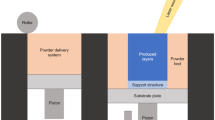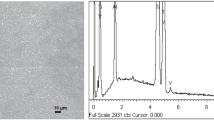Abstract
Ultrafine glass–ceramic polishing is very challenging due to structural inconsistencies, chemical inhomogeneity and high stiffness. In the modern optics sectors, glass–ceramics are extensively used. In the present study, two different experimental setups of rotational-magnetorheological glass–ceramic polishing (R-MRGP) process are used to super-finish the complex freeform curved profiles of the glass–ceramic workpiece. After polishing, the performance of both R-MRGP process setups is compared in terms of uniformity in surface roughness, surface reflectance characteristics, surface topographical images and material removal rate (MRR). Further, magnetostatics fluid-flow analysis is performed for both R-MRGP process setups to study the distributions of magnetic flux density (MFD), axial velocity and shear stress along the glass–ceramic profile. This finite element analysis (FEA) helps in recognizing the polishing capability of R-MRGP process setups. In the current study, finishing force analysis is also performed to develop a theoretical model for predicting and comparing the obtained MRR in both R-MRGP process setups. The final outcome demonstrates that the workpiece has an excellent surface quality, with a minimum achieved roughness of 1.91 nm after using the R-MRGP process setup-II. The versatility of the R-MRGP process makes it a viable option for ultra-precision polishing of glass–ceramics.



















Similar content being viewed by others
Abbreviations
- A p :
-
Normal projected area of working surface (m2)
- A :
-
Magnet vector potential (Tm or Wb/m)
- B :
-
MFD (T) or (Wb/m2)
- B (x) :
-
MFD variation in working gap (x) (T)
- Brem :
-
Remnant magnetic flux (A/m)
- D i :
-
Indentation diameter (m)
- D g :
-
Abrasive particle diameter in (m)
- F :
-
Volumetric body force (N/m3)
- F c :
-
Cutting force (N)
- F indentation :
-
Normal indentation force (N)
- F m :
-
Normal magnetic force (N)
- F s :
-
Shear force (N)
- F t :
-
Tangential force (N)
- F cen :
-
Centrifugal force acting on active abrasive (N)
- H :
-
Magnetic field intensity (A/m)
- H BHN :
-
Brinell hardness number
- H 0 :
-
Saturation magnetic field strength (A/m)
- m :
-
Consistency index
- M :
-
IPs magnetization (A-m2/Kg)
- M m :
-
Mass magnetization (emu/g)
- M s :
-
Saturation magnetization (A/m)
- Mmrpf :
-
MR fluid particle magnetization (A/m)
- m ip :
-
Mass of IPs (kg)
- m AP :
-
Mass of abrasives (kg)
- N :
-
Magnets rotational speed (rpm)
- N g :
-
Amount of active abrasives
- p :
-
Pressure exerted on workpiece profile by MRPF (N/m2)
- R a :
-
Centre-line-average (CLA) surface roughness value (nm)
- t :
-
Depth of indentation (m)
- u :
-
MRPF velocity (m /s)
- V :
-
Volume fraction of MRPF’s elements
- μ 0 :
-
Relative permeability of free space (Wb/A.m)
- μ r :
-
Relative permeability of the permanent magnet
- ρ MRP :
-
MRPF density (g/cm3)
- ρ :
-
MRPF’s elements density (g/cm3)
- μ :
-
Plastic viscosity (Pa.s)
- τ y :
-
Yield stress (kPa)
- τ :
-
Shear stress (kPa)
- ϕ :
-
Volume fraction of IPs
- η :
-
Apparent viscosity (kg/(m.s))
- χ :
-
Mass magnetic susceptibility of IPs (m3/kg)
- ω :
-
Angular velocity (rad/s
References
Kumar, M.; Kumar, A.; Alok, A.; Das, M.: Magnetorheological method applied to optics polishing: a review. IOP Conf. Ser. Mater. Sci. Eng. 804, 12–13 (2020). https://doi.org/10.1088/1757-899X/804/1/012012
Van Den Breemer, C.R.G.; Gresnigt, M.M.M.; Cune, M.S.: Cementation of glass-ceramic posterior restorations: a systematic review. Biomed Res. Int. 50, 16–25 (2015). https://doi.org/10.1155/2015/148954
Wan, L.; Liu, Z.; Deng, Z.; Li, L.; Liu, W.: Simulation and experimental research on subsurface damage of silicon nitride grinding. Ceram. Int. 44, 8290–8296 (2018). https://doi.org/10.1016/j.ceramint.2018.02.014
Zhu, W.L.; Beaucamp, A.: Ultra-precision finishing of low expansion ceramics by compliant abrasive technologies: a comparative study. Ceram. Int. 45, 11527–11538 (2019). https://doi.org/10.1016/j.ceramint.2019.03.022
Wang, C.; Wang, H.; Gao, R.; Zhang, M.; Liu, S.; Hou, J.; Chen, X.: Experimental investigation on thermal healing of subsurface damage in borosilicate glass. Ceram. Int. 45, 19874–19889 (2021). https://doi.org/10.1016/j.ceramint.2021.03.022
Lambropoulos, J.C.; Gillman, B.E.; Zhou, Y.Y.; Jacobs, S.D.; Stevens, H.J.: Glass-ceramics: deterministic microgrinding, lapping, and polishing. Opt. Manuf. Test. II(3134), 178–189 (1997). https://doi.org/10.1117/12.279119
Zhao, Y.; Zhang, L.; Yang, Z.: Experimental investigation into electrorheological fluid-assisted polishing of glass-ceramic. Appl. Mech. Mater. 184–185, 977–980 (2012). https://doi.org/10.4028/www.scientific.net/AMM.184-185.977
Gorodkin, G.; Novikova, Z.: Influence of flowing parameter of magnetorheological polishing fluids (MRPFs) on the quality of processing polycrystalline glass ceramics. J. Intell. Mater. Syst. Struct. 23, 959–962 (2012). https://doi.org/10.1177/1045389X11428365
Zhou, P.; Guo, P.: Research of the residual stress in grinding surface of glass-ceramics. 7th Int. Symp. Adv. Opt. Manuf. Test. Technol. Adv. Opt. Manuf. Technol. 9281, 92812 (2014). https://doi.org/10.1117/12.2068289
Xu, L.; Lei, H.: Nano-scale surface of ZrO2 ceramics achieved efficiently by peanut-shaped and heart-shaped SiO2 abrasives through chemical mechanical polishing. Ceram. Int. 46, 13297–13306 (2020). https://doi.org/10.1016/j.ceramint.2020.02.108
Bedi, T.S.; Singh, A.K.: Magnetorheological methods for nanofinishing—a review. Part. Sci. Technol. 34, 412–422 (2016). https://doi.org/10.1080/02726351.2015.1081657
Das, M.; Jain, V.K.; Ghoshdastidar, P.S.: Nanofinishing of flat workpieces using rotational-magnetorheological abrasive flow finishing (R-MRAFF) process. Int. J. Adv. Manuf. Technol. 62, 405–420 (2012). https://doi.org/10.1007/s00170-011-3808-2
Bhatt, G.; Batish, A.; Bhattacharya, A.: Experimental investigation of magnetic field assisted powder mixed electric discharge machining. Part. Sci. Technol. 33, 246–256 (2015). https://doi.org/10.1080/02726351.2014.968303
Kumar, M.; Yadav, H.N.S.; Kumar, A.; Das, M.: An overview of magnetorheological polishing fluid applied in nano-finishing of components. J. Micromanuf. 3, 1–19 (2021). https://doi.org/10.1177/25165984211008173
Jha, S.; Jain, V.K.: Modeling and simulation of surface roughness in magnetorheological abrasive flow finishing (MRAFF) process. Wear 261, 856–866 (2006). https://doi.org/10.1016/j.wear.2006.01.043
Sadiq, A.; Shunmugam, M.S.: Magnetic field analysis and roughness prediction in magnetorheological abrasive honing (MRAH). 13, 246–268. (2009).https://doi.org/10.1080/10910340903011805
Das, M.; Jain, V.K.; Ghoshdastidar, P.S.: Fluid flow analysis of magnetorheological abrasive flow finishing (MRAFF) process. Int. J. Adv. Manuf. Technol. 38, 613–621 (2008). https://doi.org/10.1007/s00170-007-1095-8
Ginder, J.M.; Davis, L.C.; Elie, L.D.: Rheology of magnetorheology fluids: models and measurements. Int. J. Mod. Phys. 10, 11 (1996)
Kheradmand, S.; Esmailian, M.; Fatahy, A.: Numerical simulation of the combination effect of external magnetic field and rotating workpiece on abrasive flow finishing. J. Mech. Sci. Technol. 31, 1835–1841 (2017). https://doi.org/10.1007/s12206-017-0232-z
Alam, Z.; Jha, S.: Reprint of ‘“Modeling of surface roughness in ball end magnetorheological finishing (BEMRF) process”.’ Wear 376–377, 194–202 (2017). https://doi.org/10.1016/j.wear.2017.04.007
Paswan, S.K.; Bedi, T.S.; Singh, A.K.: Modeling and simulation of surface roughness in magnetorheological fluid based honing process. Wear 376–377, 1207–1221 (2017). https://doi.org/10.1016/j.wear.2016.11.025
Paswan, S.K.; Singh, A.K.: Analysis of surface finishing mechanism in a newly developed rotational magnetorheological honing process for its productivity improvement. Wear 426–427, 68–82 (2019). https://doi.org/10.1016/j.wear.2019.01.001
Ravi Datt Yadav, A.K.S.: A novel magnetorheological gear profile finishing with high shape accuracy. Int. J. Mach. Tools Manuf. 139, 75–92 (2019). https://doi.org/10.1016/j.ijmachtools.2019.02.001
Kim, B.C.; Chung, J.H.; Cho, M.W.; Ha, S.J.; Yoon, G.S.: Magnetorheological fluid polishing using an electromagnet with straight pole-piece for improving material removal rate. J. Mech. Sci. Technol. 32, 3345–3350 (2018). https://doi.org/10.1007/s12206-018-0637-3
Liu, X.; Xu, X.: Ultra-fine polishing of glass-ceramics by disaggregated and fractionated detonation nanodiamond. Ceram. Int. 43, 6063–6068 (2017). https://doi.org/10.1016/j.ceramint.2017.01.150
Acknowledgements
We acknowledge the Science & Engineering Research Board (SERB), New Delhi, India, for their financial assistance for project No. EEQ/2017/000597 titled "Fabrication of Prosthetic Im-plants and further Nanofinishing using Magnetic Field Assisted Finishing (MFAF) Process."
Author information
Authors and Affiliations
Corresponding author
Rights and permissions
About this article
Cite this article
Kumar, M., Das, M. Performance Evaluation of Rotational-Magnetorheological Glass–Ceramic Polishing (R-MRGP) Process Setups. Arab J Sci Eng 47, 15269–15284 (2022). https://doi.org/10.1007/s13369-021-06504-8
Received:
Accepted:
Published:
Issue Date:
DOI: https://doi.org/10.1007/s13369-021-06504-8




